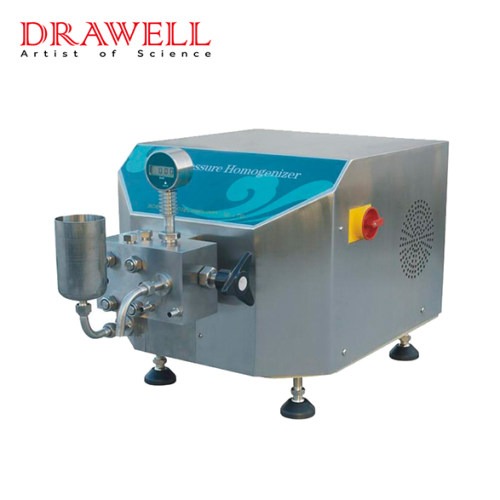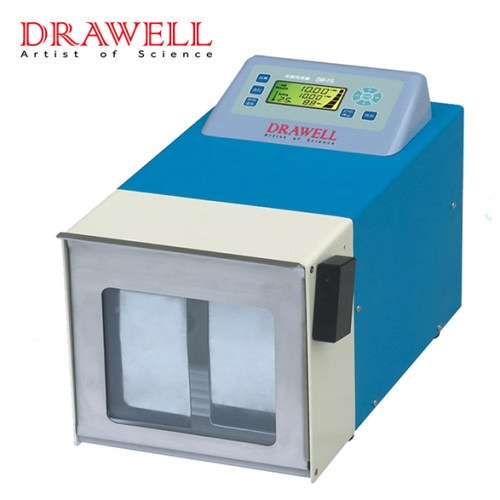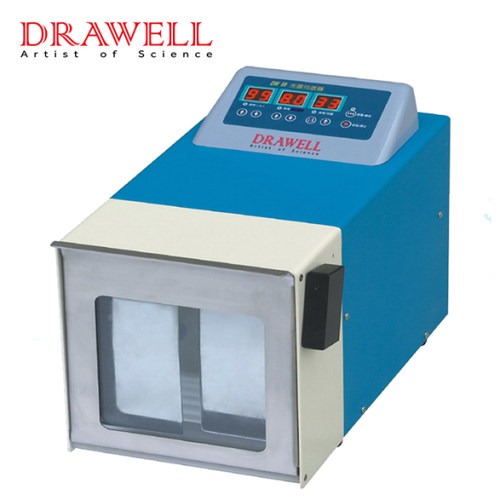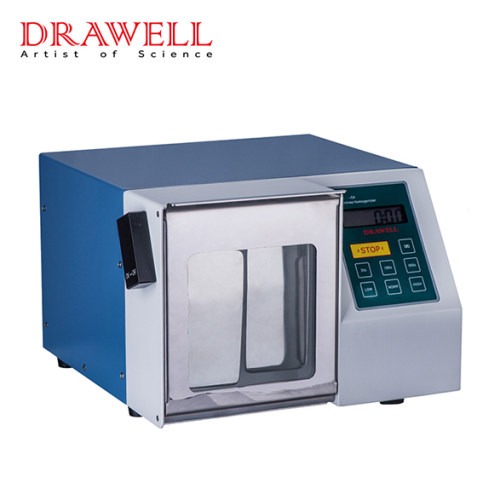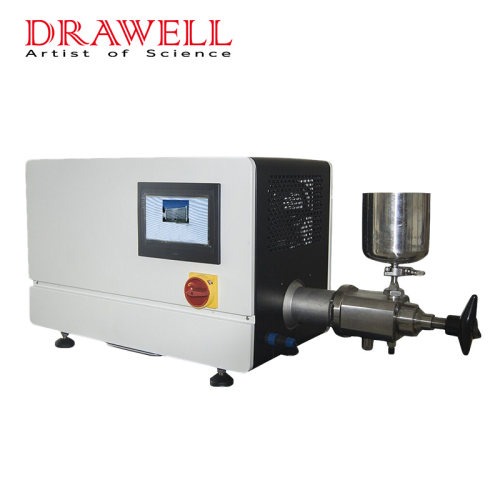In the dynamic world of biotechnology, sample homogenization plays a crucial role in unlocking the secrets within cellular structures and complex mixtures. Two titans of this realm, the high-pressure homogenizer and the ultrasonic homogenizer, stand ready to deliver efficient sample breakdown. But when it comes to sheer power and versatility, the high-pressure homogenizer packs a punch that ultrasonic rivals cannot match. Let’s delve into the six key advantages that set this champion apart.
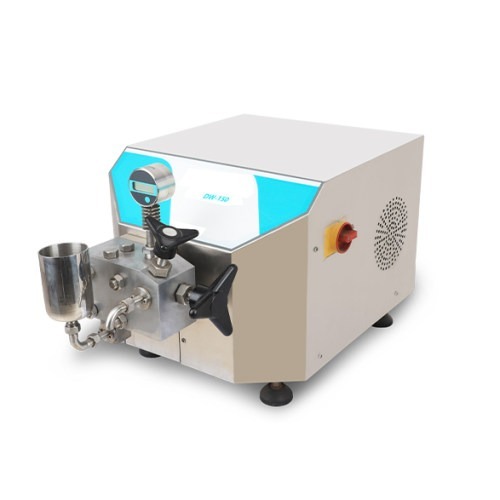
1. High Homogenization Efficiency:
High-pressure homogenizers achieve exceptional homogenization efficiency through a mechanical shearing action. Samples are subjected to high-velocity forced flow through a narrow gap defined by a precisely engineered homogenization valve. This valve houses a rapidly rotating rotor with intricate blade geometry, generating intense shear forces that disrupt, fragment, and disperse the sample. This mechanical comminution process leads to a highly uniform particle size distribution, ensuring effective homogenization across a wide range of sample types.
In comparison, ultrasonic homogenizers primarily rely on cavitation, a phenomenon where high-frequency sound waves create microscopic bubbles within the sample. These bubbles rapidly collapse, generating localized shockwaves and shear forces that disrupt the sample. While effective for certain applications, ultrasonic homogenizers might not achieve the same level of homogenization efficiency as HPHs due to limitations in cavitation intensity and uneven distribution within the sample volume.
2. Wide Applicability
High-pressure homogenizers exhibit exceptional versatility in homogenizing a wide spectrum of biological materials. Their ability to generate high pressures (up to 1000 MPa) and potent shearing forces makes them well-suited for disrupting tough cell walls, lysing organelles, and fragmenting tissues. This adaptability extends to various sample matrices, including:
- Cells: Bacterial, fungal, and mammalian cells, even those with robust cell walls, can be effectively lysed by High-pressure homogenizers, enabling access to intracellular components.
- Organelles: Subcellular structures like mitochondria, nuclei, and chloroplasts can be isolated and purified through controlled homogenization with High-pressure homogenizers.
- Cell fragments: Membranous structures, cytoskeletal elements, and other cellular components can be fragmented and dispersed for further analysis.
- Microorganisms: Bacteria, yeasts, and other microbes can be efficiently lysed by HPHs, facilitating downstream processing and analysis.
- Biological tissues: Homogenization with high-pressure homogenizers can be employed for tissue disruption and extraction of biomolecules like proteins, DNA, and lipids.
While ultrasonic homogenizers can also handle similar samples, their effectiveness might be limited for high-density or fibrous tissues due to the dependence on cavitation, which can be less efficient in such matrices.
3. Ease of Operation
High-pressure homogenizers are generally considered user-friendly instruments with straightforward operation. The basic workflow involves:
- Sample preparation: Suspend the sample in a suitable buffer or medium.
- Parameter selection: Set homogenization parameters like pressure, passes through the homogenization valve, and processing time based on the desired outcome and sample characteristics.
- Homogenization: Load the sample into the chamber and initiate the process.
- Sample collection: Collect the homogenized sample for further analysis or downstream processing.
In contrast, ultrasonic homogenizers may require additional considerations due to the potential impact of parameters like probe placement, sonication duration, and amplitude on the homogenization outcome. Optimizing these parameters can be more involved compared to the standardized operation of high-pressure homogenizers.
4. Longevity
High-pressure homogenizers are typically constructed from high-strength, wear-resistant materials like stainless steel and ceramics to withstand the intense pressures and shearing forces involved in the homogenization process. This robust design contributes to their long lifespan and reliable operation.
On the other hand, ultrasonic homogenizers rely on piezoelectric transducers to generate ultrasonic vibrations, which are more delicate components compared to the mechanical parts of high-pressure homogenizers. This can make them more susceptible to damage from factors like improper cleaning, overheating, or accidental dropping, potentially leading to reduced lifespan and downtime for repairs.
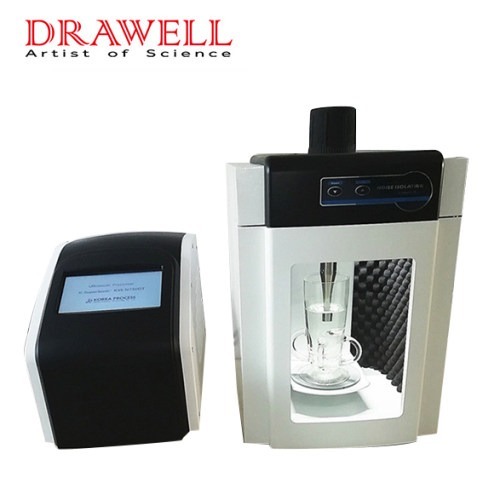
5. High Control Precision
High-pressure homogenizers offer a high degree of control over the homogenization process through various adjustable parameters:
- Rotation speed: Higher speeds generate more intense shearing forces, suitable for challenging samples but requiring careful optimization to avoid excessive heat generation.
- Blade spacing: Adjusting the gap between the rotor and stator blades influences the shearing intensity and particle size distribution.
- Number of passes: Multiple passes through the homogenization valve can be employed for progressive disruption and achieving the desired particle size reduction.
- Homogenization time: Precise control over processing time allows for tailored homogenization, balancing efficiency with potential sample degradation.
This comprehensive control allows researchers to fine-tune the homogenization process for specific sample characteristics and desired outcomes. In comparison, ultrasonic homogenizers offer less control over the homogenization mechanism, primarily relying on adjusting the vibration frequency and amplitude, which have a more limited impact on the overall homogenization efficiency and particle size distribution.
6. Lower Energy Consumption
While high-pressure homogenizers require significant initial power input to generate high pressures, their energy consumption can be relatively low for samples requiring short homogenization times. This is because the homogenization process is efficient, and the power draw drops significantly once the target pressure is reached. In contrast, ultrasonic homogenizers typically operate at lower power levels but require longer sonication times to achieve similar homogenization effects, potentially resulting in higher overall energy consumption.
It’s crucial to consider the sample volume and desired level of homogenization when comparing energy efficiency. For small volumes and moderate homogenization requirements, ultrasonic homogenizers might be more energy-efficient. However, for larger volumes and demanding homogenization tasks, high-pressure homogenizers become advantageous due to their faster processing times and lower overall energy consumption per processed volume.
In summary, the high-pressure homogenizer holds certain advantages over the ultrasonic homogenizer in terms of high homogenization efficiency, wide applicability, ease of operation, longevity, high control precision, and lower energy consumption. However, the choice between these homogenization devices should be based on comprehensive considerations, taking into account the specific requirements and characteristics of the samples at hand.


